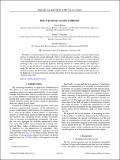Role of persistent cascades in diffusion
Author(s)
González, Marta C.; Morse, Steven T.; Markuzon, Natasha
DownloadPhysRevE.99.012323.pdf (705.9Kb)
PUBLISHER_POLICY
Publisher Policy
Article is made available in accordance with the publisher's policy and may be subject to US copyright law. Please refer to the publisher's site for terms of use.
Terms of use
Metadata
Show full item recordAbstract
We define a structural property of real-world large-scale communication networks consisting of the recurring patterns of communication among individuals, which we term persistent cascades. Using methods of inexact tree matching and agglomerative clustering, we group these patterns into classes which we claim represent some underlying way in which individuals tend to disseminate information. We extend methods from epidemic modeling to offer a way to analytically model this recurring structure in a random network, and comparing to the data, we find that the real cascading structure is significantly larger and more recurrent than the random model. We find that the cascades reveal a habitual hierarchy of spreading, alternative roles in weekday vs weekend spreading, and the existence of hidden spreaders. Finally, we show that cascade membership increases the likelihood of receiving information spreading through the network through simulation on the real order of communication events.
Date issued
2019-01Department
Charles Stark Draper Laboratory; Massachusetts Institute of Technology. Operations Research CenterJournal
Physical Review E
Publisher
American Physical Society
Citation
Morse, Steven et al. "Role of persistent cascades in diffusion." Physical Review E 99, 1 (January 2019): 012323 © 2019 American Physical Society
Version: Final published version
ISSN
2470-0045
2470-0053